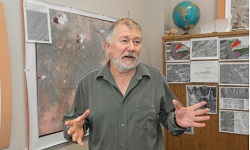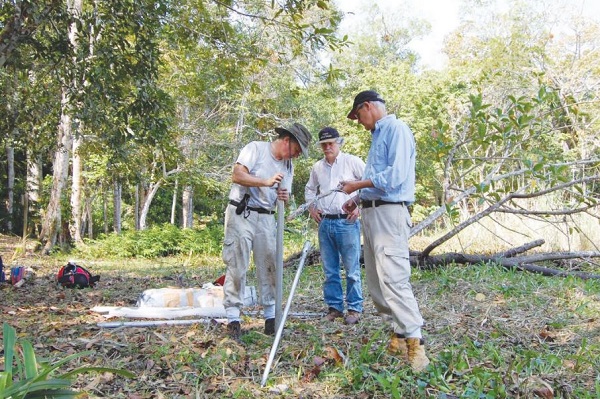Global Water Issue
“고대 마야인, 정교한 정수필터 만들어 사용”
마야 중심도시 티칼서 정수처리 위해 석영 등 천연재료 수입 정황 확인
도시 주요 식수 공급원인 코리엔탈 저수지서 정수필터 시스템 흔적 발견
미 신시내티대 연구진 “마야 문명의 도시 티칼, 깨끗한 식수 통해 번성”
고대 마야가 만든 정교한 정수필터
Ancient Maya Built Sophisticated Water Filters
과테말라 플로레스(Flores)에 위치한 티칼(Tikal)은 고대 마야(Maya) 문명의 흔적을 간직한 대표 도시다. 고고학자들의 연구에 따르면 이 도시는 정치·경제의 중심지이며 인구는 최대 10만 명을 넘었던 것으로 추정된다. 특히, 5세기부터 9세기까지 500년 넘게 번영을 거듭한 것으로 추정된다. 티칼이 이 같이 번성한 데에는 깨끗한 식수가 한 몫 했다는 연구결과가 나왔다. 최근 미국 신시내티대학교 고고학 분야 연구진은 티칼을 비롯한 마야의 주요 식수 공급원인 코리엔탈 저수지에서 천연재료를 사용해 정수필터를 만들어 사용한 흔적을 발견했다고 밝혔다. 연구결과는 네이처 자매지인 『사이언티픽 리포트(Scientific Reports)』에 게재됐다. 관련 기사 내용을 번역했다.
한때 번성했던 고대 마야(Maya) 문명의 도시 ‘티칼(Tikal)’에서는 수마일 떨어진 곳에서 가져온 천연재료를 사용하여 정교한 정수필터를 만들어 사용했다고 미국 신시내티대학교(University of Cincinnati, UC) 연구진이 밝혔다. 신니내티대 연구진은 현재 과테말라 북부에 있는 고대 마야의 식수 공급원인 코리엔탈 저수지(Corriental reservoir)에서 필터 시스템의 증거를 발견했다.
인류학자, 지리학자 및 생물학자 등 다양한 분야 전문가들로 구성된 연구진은 티칼에서 수 마일 떨어진 곳에서 수입한 결정질 석영(crystalline)과 제올라이트를 확인했다. 거친 모래에서 발견된 석영은 실리콘 및 알루미늄으로 구성된 결정성 화합물인 제올라이트와 함께 천연분자체(natural molecular sieve)를 만들어낸다. 두 광물 모두 현대 정수처리에 사용된다.
Ancient Maya in the once-bustling city of Tikal built sophisticated water filters using natural materials they imported from miles away, according to the University of Cincinnati.UC researchers discovered evidence of a filter system at the Corriental reservoir, an important source of drinking water for the ancient Maya in what is now northern Guatemala.
A multidisciplinary team of UC anthropologists, geographers and biologists identified crystalline quartz and zeolite imported miles from the city. The quartz found in the coarse sand along with zeolite, a crystalline compound consisting of silicon and aluminum, create a natural molecular sieve. Both minerals are used in modern water filtration.


신시내티대 연구진의 이번 발견은 『사이언티픽 리포트(Scientific Reports)』에 게재됐다. 이 프로젝트는 연구진의 연구에 대한 의지를 보여주며, ‘Next Lives Here(미래가 여기에 있다)’(https://www.uc.edu/about/strategic-direction.html)라는 신시내티대학교의 전략적 방향과도 잘 들어맞는다.
탱커슬리(Tankersley) 박사는 “고대 마야인들은 유럽에서 이것과 유사한 시스템이 사용되기 2천여 년 전에 이 정수필터 시스템을 만들었다”면서 “이것은 세계에서 가장 오래된 정수처리 시스템 중 하나가 되었다”고 말했다.
The filters would have removed harmful microbes, nitrogen-rich compounds, heavy metals such as mercury and other toxins from the water, said Kenneth Barnett Tankersley, associate professor of anthropology and lead author of the study. “What’s interesting is this system would still be effective today and the Maya discovered it more than 2,000 years ago,” Tankersley said.
UC’s discovery was published in the journal Scientific Reports. The project demonstrates UC's commitment to research as described in its strategic direction called Next Lives Here(https://www.uc.edu/about/strategic-direction.html).
The Maya created this water filtration system nearly 2,000 years before similar systems were used in Europe, making it one of the oldest water treatment systems of its kind in the world, Tankersley said.
신시내티대 예술과학대학 연구원들은 티칼에서 북동쪽으로 약 18마일 떨어진 바조 데 아즈카르(Bajo de Azucar) 주변의 가파른 능선까지 제올라이트와 석영들을 추적했다. 이들은 저수지 침전물 내 제올라이트 및 결정 석영량을 조사하고자 X선 회절 분석(X-ray diffraction analysis)을 사용했다. 티칼에서는 제올라이트가 코리엔탈 저수지(Corriental reservoir)에서만 발견되었다.
고대 마야에게는 깨끗한 물을 모으고 저장하는 방법을 찾는 것이 매우 중요했다. 티칼 및 다른 마야 도시들은 다공성 석회암 위에 지어졌다. 이 때문에 계절적 가뭄으로 일년 내내 식수를 구하기가 어려웠다.
Researchers from UC’s College of Arts and Sciences traced the zeolite and quartz to steep ridges around the Bajo de Azucar about 18 miles northeast of Tikal. They used X-ray diffraction analysis to identify zeolite and crystalline quartz in the reservoir sediments. At Tikal, zeolite was found exclusively in the Corriental reservoir.
For the ancient Maya, finding ways to collect and store clean water was of critical importance. Tikal and other Maya cities were built atop porous limestone that made ready access to drinking water difficult to obtain for much of the year during seasonal droughts.

니콜라스 더닝 교수는 “석영 알갱이와 제올라이트로 이뤄진, 노출되고 풍화된 화산 응회암(volcanic tuff)이었다. 좋은 속도로 물이 흘러나오고 있었다”라면서 “연구원들은 그 물로 물병을 다시 채웠다. 물이 얼마나 깨끗하고 달콤한지 현지에서도 유명했다”라고 말했다. 더닝 교수는 화산 응회암의 샘플을 채취했다. 신시내티대 연구원들은 나중에 이 석영과 제올라이트가 티칼에서 발견된 광물과 거의 일치한다는 것을 알아냈다.
고대 마야 도시 티칼은 결국 도시가 버려지기 전인 5세기에서 9세기 사이에 번성했다. 크리스토퍼 카(Christopher Carr) 지리정보시스템 매핑 전문가 겸 신시내티대 조교수 또한 바조 데 아즈카르와 코리엔탈에서 신시내티대 프로젝트 작업을 수행했다.
UC geography professor and co-author Nicholas Dunning, who has studied ancient civilizations most of his career, found a likely source of the quartz and zeolite about 10 years ago while conducting fieldwork in Guatemala.
“It was an exposed, weathered volcanic tuff of quartz grains and zeolite. It was bleeding water at a good rate,” he said. “Workers refilled their water bottles with it. It was locally famous for how clean and sweet the water was.” Dunning took samples of the material. UC researchers later determined the quartz and zeolite closely matched the minerals found at Tikal.
The ancient Maya city of Tikal flourished between the fifth and ninth centuries before the city eventually was abandoned. UC assistant research professor Christopher Carr, an expert in geographic information system mapping, also conducted work on the UC projects at Bajo de Azucar and Corriental.

더닝 교수는 “고대 마야인들이 이 특별한 물질과 깨끗한 물이 연관되었다는 것을 알고 이것을 가져오려 노력한 것은 아마도 매우 영리하고 경험적인 관찰을 통해서였을 것”이라며 “그들은 저수지로 물이 유입되기 전에 저수지로 물을 흘려보낼 수 있는 침전조를 가지고 있었다. 이 때문에 아마도 물은 더 깨끗하고 맛도 좋았을 것”이라고 말했다.
올해 초 『사이언티픽 리포트』에 게재된 관련 논문에 따르면 신시내티대 연구진은 티칼의 일부 저수지는 유해한 수준의 수은으로 오염되었고, 이는 마야인이 석고 벽과 매장 풍습에 사용한 ‘진사(cinnabar)’라는 색소에서 유래했을 것으로 추정했다. 코리엔탈에서는 이러한 오염물질이 발견되지 않았다.
“It was probably through very clever empirical observation that the ancient Maya saw this particular material was associated with clean water and made some effort to carry it back,” Dunning said. “They had settling tanks where the water would be flowing toward the reservoir before entering the reservoir. The water probably looked cleaner and probably tasted better, too,” he said.
In a related paper published earlier this year in Scientific Reports, UC’s research team found that some reservoirs in Tikal eventually became polluted with toxic levels of mercury, possibly from a pigment called cinnabar the Maya used on plaster walls and in ceremonial burials. Corriental remained free of these contaminants.
또 다른 공동저자 버논 스카보로우(Vernon Scarborough) 신시내티대 인류학과 명예교수는 “고대 물관리와 관련된 대부분의 연구는 문명이 어떻게 물을 보존하고, 확보하고, 흐름을 바꾸었는지 밝혀내기 위해 노력해 왔다”라고 말했다.
스카보로우 교수는 “마실 수 있는 수질에 대한 결론은 아직 내리기 어려운 수준”이라면서 “이번 신시내티대 연구진의 연구는 수원의 수질을 어떻게 확인하고 그것이 어떻게 확립되고 유지될 수 있었는지 밝혀내기 위한 방법으로 연구 어젠다를 공개했다”고 말했다. 물론 1천 년 전 문명의 생활·관습·동기를 재구성하기란 까다롭다. 더닝 교수는 “절대적인 증거는 없지만 확실한 정황 증거는 갖고 있다”면서 “우리의 설명은 논리적으로 이치에 맞다”라고 말했다.
공동저자인 데이비드 렌츠(David Lentz) 신시내티대 생물학과 교수는 “이는 고고학자로서 해야할 일”이라면서 “일부 없어진 조각을 맞춰서 퍼즐을 풀어야 한다”고 말했다. 렌츠 교수는 이 정수처리 시스템이 고대 마야인들을 유해한 시아노박테리아(Cyanobacteria)와 기타 독소로부터 보호했을 것이며, 그렇지 않았다면 저수지 물을 마신 사람들은 병을 앓았을 것이라고 말했다. 그는 “고대 마야인들은 이 물질이 맑은 물을 만들어낸다는 것을 알아냈다”고 했다.
UC anthropology professor emeritus Vernon Scarborough, another co-author, said most research on ancient water management has tried to explain how civilizations conserved, collected or diverted water.
“The quality of water put to potable ends has remained difficult to address,” Scarborough said. “This study by our UC team has opened the research agenda by way of identifying the quality of a water source and how that might have been established and maintained.”
Of course, reconstructing the lives, habits and motivations of a civilization 1,000 years ago is tricky. “We don’t have absolute proof, but we have strong circumstantial evidence,” Dunning said. “Our explanation makes logical sense.”
“This is what you have to do as an archaeologist,” UC biologist and co-author David Lentz said. “You have to put together a puzzle with some of the pieces missing.” Lentz said the filtration system would have protected the ancient Maya from harmful cyanobacteria and other toxins that might otherwise have made people who drank from the reservoir sick. “The ancient Maya figured out that this material produced pools of clear water,” he said.

탱커슬리 박사는 “그리스부터 이집트, 남아시아에 이르는 다른 고대 문명권에서도 정교한 정수처리 시스템이 발견된 적이 있지만 고대 신대륙(아메리카)에서 발견된 것은 처음”이라고 말했다.
또한 박사는 “고대 마야인들은 열대 환경에서 살아남기 위해 혁신자가 되어야 했고 이것은 놀라운 혁신이다”라고 말했다. 이어 그는 “많은 사람들이 서반구의 아메리카 원주민들은 그리스, 로마, 인도, 중국 등의 나라와 같은 수준의 기술력을 가지고 있지 않다고 생각한다. 하지만 물관리에 있어 마야인들은 수천 년 앞서 있었다”고 말했다.
탱커슬리 박사는 그가 대답하고 싶은 다음 질문이 ‘이러한 정수처리 시스템이 고대 마야 문명에 얼마나 보편화되어 있었는지’에 관한 것이라고 했다. 신시내티대 연구진은 고대 마야인들이 소중한 저수지를 보존하기 위해 어떻게 침식을 막았는지에 대해 연구하고 있다.
Complex water filtration systems have been observed in other ancient civilizations from Greece to Egypt to South Asia, but this is the first observed in the ancient New World, Tankersley said.
“The ancient Maya lived in a tropical environment and had to be innovators. This is a remarkable innovation,” Tankersley said. “A lot of people look at Native Americans in the Western Hemisphere as not having the same engineering or technological muscle of places like Greece, Rome, India or China. But when it comes to water management, the Maya were millennia ahead.”
Tankersley said the next question he would like to answer is how widespread these filtration systems might have been across the ancient Mayan civilization. UC’s team is also studying how the ancient Maya prevented erosion from harming their prized reservoirs.
[출처 = 워터온라인(www.wateronline.com/doc/ancient-maya-built-sophisticated-water-filters-0001) / 2020년 10월 22일]
[『워터저널』 2020년 12월호에 게재]

